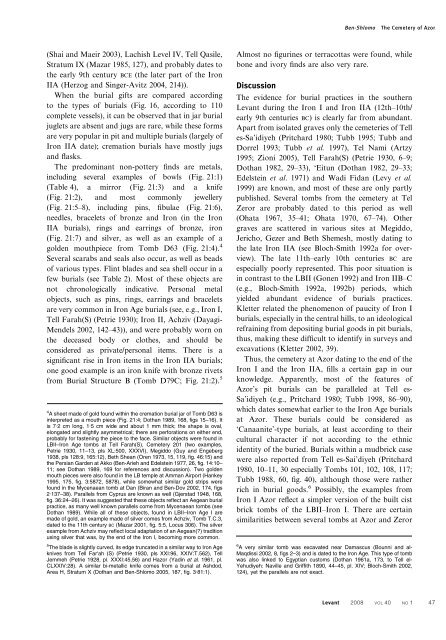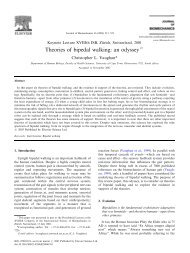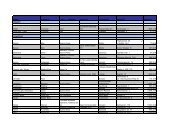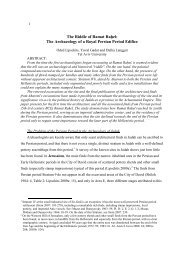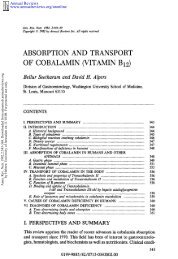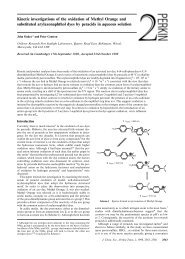The Cemetery of Azor and Early Iron Age Burial Practices
The Cemetery of Azor and Early Iron Age Burial Practices
The Cemetery of Azor and Early Iron Age Burial Practices
You also want an ePaper? Increase the reach of your titles
YUMPU automatically turns print PDFs into web optimized ePapers that Google loves.
Ben-Shlomo<strong>The</strong> <strong>Cemetery</strong> <strong>of</strong> <strong>Azor</strong>(Shai <strong>and</strong> Maeir 2003), Lachish Level IV, Tell Qasile,Stratum IX (Mazar 1985, 127), <strong>and</strong> probably dates tothe early 9th century BCE (the later part <strong>of</strong> the <strong>Iron</strong>IIA (Herzog <strong>and</strong> Singer-Avitz 2004, 214)).When the burial gifts are compared accordingto the types <strong>of</strong> burials (Fig. 16, according to 110complete vessels), it can be observed that in jar burialjuglets are absent <strong>and</strong> jugs are rare, while these formsare very popular in pit <strong>and</strong> multiple burials (largely <strong>of</strong><strong>Iron</strong> IIA date); cremation burials have mostly jugs<strong>and</strong> flasks.<strong>The</strong> predominant non-pottery finds are metals,including several examples <strong>of</strong> bowls (Fig. 21:1)(Table 4), a mirror (Fig. 21:3) <strong>and</strong> a knife(Fig. 21:2), <strong>and</strong> most commonly jewellery(Fig. 21:5–8), including pins, fibulae (Fig. 21:6),needles, bracelets <strong>of</strong> bronze <strong>and</strong> <strong>Iron</strong> (in the <strong>Iron</strong>IIA burials), rings <strong>and</strong> earrings <strong>of</strong> bronze, iron(Fig. 21:7) <strong>and</strong> silver, as well as an example <strong>of</strong> agolden mouthpiece from Tomb D63 (Fig. 21:4). 4Several scarabs <strong>and</strong> seals also occur, as well as beads<strong>of</strong> various types. Flint blades <strong>and</strong> sea shell occur in afew burials (see Table 2). Most <strong>of</strong> these objects arenot chronologically indicative. Personal metalobjects, such as pins, rings, earrings <strong>and</strong> braceletsare very common in <strong>Iron</strong> <strong>Age</strong> burials (see, e.g., <strong>Iron</strong> I,Tell Farah(S) (Petrie 1930); <strong>Iron</strong> II, Achziv (Dayagi-Mendels 2002, 142–43)), <strong>and</strong> were probably worn onthe deceased body or clothes, <strong>and</strong> should beconsidered as private/personal items. <strong>The</strong>re is asignificant rise in <strong>Iron</strong> items in the <strong>Iron</strong> IIA burials;one good example is an iron knife with bronze rivetsfrom <strong>Burial</strong> Structure B (Tomb D79C; Fig. 21:2). 54 A sheet made <strong>of</strong> gold found within the cremation burial jar <strong>of</strong> Tomb D63 isinterpreted as a mouth piece (Fig. 21:4; Dothan 1989, 168, figs 15–16). Itis 7 . 2 cm long, 1 . 5 cm wide <strong>and</strong> about 1 mm thick; the shape is oval,elongated <strong>and</strong> slightly asymmetrical; there are perforations on either end,probably for fastening the piece to the face. Similar objects were found inLBII–<strong>Iron</strong> <strong>Age</strong> tombs at Tell Farah(S), <strong>Cemetery</strong> 201 (two examples,Petrie 1930, 11–13, pls XL:500, XXXVI), Megiddo (Guy <strong>and</strong> Engeberg1938, pls 128:9, 165:12), Beth Shean (Oren 1973, 15, 119, fig. 46:15) <strong>and</strong>the Persian Garden at Akko (Ben-Arieh <strong>and</strong> Edelstein 1977, 26, fig. 14:10–11; see Dothan 1989, 169 for references <strong>and</strong> discussion). Two goldenmouth pieces were also found in the LB temple at Amman Airport (Hankey1995, 175, fig. 3:5872, 5878), while somewhat similar gold strips werefound in the Mycenaean tomb at Dan (Biran <strong>and</strong> Ben-Dov 2002, 174, figs2 . 137–38). Parallels from Cyprus are known as well (Gjerstad 1948, 168,fig. 36:24–26). It was suggested that these objects reflect an Aegean burialpractice, as many well known parallels come from Mycenaean tombs (seeDothan 1989). While all <strong>of</strong> these objects, found in LBII–<strong>Iron</strong> <strong>Age</strong> I aremade <strong>of</strong> gold, an example made <strong>of</strong> silver comes from Achziv, Tomb T.C.3,dated to the 11th century BC (Mazar 2001, fig. 5:5, Locus 306). <strong>The</strong> silverexample from Achziv may reflect local adaptation <strong>of</strong> an Aegean(?) traditionusing silver that was, by the end <strong>of</strong> the <strong>Iron</strong> I, becoming more common.5 <strong>The</strong> blade is slightly curved, its edge truncated in a similar way to <strong>Iron</strong> <strong>Age</strong>knives from Tell Far‘ah (S) (Petrie 1930, pls XXI:96, XXIV:T.562), TellJemmeh (Petrie 1928, pl. XXXI:45,56) <strong>and</strong> Hazor (Yadin et al. 1961, pl.CLXXIV:28). A similar bi-metallic knife comes from a burial at Ashdod,Area H, Stratum X (Dothan <strong>and</strong> Ben-Shlomo 2005, 187, fig. 3 . 81:1).Almost no figurines or terracottas were found, whilebone <strong>and</strong> ivory finds are also very rare.Discussion<strong>The</strong> evidence for burial practices in the southernLevant during the <strong>Iron</strong> I <strong>and</strong> <strong>Iron</strong> IIA (12th–10th/early 9th centuries BC) is clearly far from abundant.Apart from isolated graves only the cemeteries <strong>of</strong> Telles-Sa’idiyeh (Pritchard 1980; Tubb 1995; Tubb <strong>and</strong>Dorrel 1993; Tubb et al. 1997), Tel Nami (Artzy1995; Zioni 2005), Tell Farah(S) (Petrie 1930, 6–9;Dothan 1982, 29–33), ‘Eitun (Dothan 1982, 29–33;Edelstein et al. 1971) <strong>and</strong> Wadi Fidan (Levy et al.1999) are known, <strong>and</strong> most <strong>of</strong> these are only partlypublished. Several tombs from the cemetery at TelZeror are probably dated to this period as well(Ohata 1967, 35–41; Ohata 1970, 67–74). Othergraves are scattered in various sites at Megiddo,Jericho, Gezer <strong>and</strong> Beth Shemesh, mostly dating tothe late <strong>Iron</strong> IIA (see Bloch-Smith 1992a for overview).<strong>The</strong> late 11th–early 10th centuries BC areespecially poorly represented. This poor situation isin contrast to the LBII (Gonen 1992) <strong>and</strong> <strong>Iron</strong> IIB–C(e.g., Bloch-Smith 1992a, 1992b) periods, whichyielded abundant evidence <strong>of</strong> burials practices.Kletter related the phenomenon <strong>of</strong> paucity <strong>of</strong> <strong>Iron</strong> Iburials, especially in the central hills, to an ideologicalrefraining from depositing burial goods in pit burials,thus, making these difficult to identify in surveys <strong>and</strong>excavations (Kletter 2002, 39).Thus, the cemetery at <strong>Azor</strong> dating to the end <strong>of</strong> the<strong>Iron</strong> I <strong>and</strong> the <strong>Iron</strong> IIA, fills a certain gap in ourknowledge. Apparently, most <strong>of</strong> the features <strong>of</strong><strong>Azor</strong>’s pit burials can be paralleled at Tell es-Sa’idiyeh (e.g., Pritchard 1980; Tubb 1998, 86–90),which dates somewhat earlier to the <strong>Iron</strong> <strong>Age</strong> burialsat <strong>Azor</strong>. <strong>The</strong>se burials could be considered as‘Canaanite’-type burials, at least according to theircultural character if not according to the ethnicidentity <strong>of</strong> the buried. <strong>Burial</strong>s within a mudbrick casewere also reported from Tell es-Sai’diyeh (Pritchard1980, 10–11, 30 especially Tombs 101, 102, 108, 117;Tubb 1988, 60, fig. 40), although those were ratherrich in burial goods. 6 Possibly, the examples from<strong>Iron</strong> I <strong>Azor</strong> reflect a simpler version <strong>of</strong> the built cistbrick tombs <strong>of</strong> the LBII–<strong>Iron</strong> I. <strong>The</strong>re are certainsimilarities between several tombs at <strong>Azor</strong> <strong>and</strong> Zeror6 A very similar tomb was excavated near Damascus (Bounni <strong>and</strong> al-Maqdissi 2002, 8, figs 2–3) <strong>and</strong> is dated to the <strong>Iron</strong> <strong>Age</strong>. This type <strong>of</strong> tombwas also linked to Egyptian customs (Dothan 1961a, 173, to Tell el-Yehudiyeh: Naville <strong>and</strong> Griffith 1890, 44–45, pl. XIV; Bloch-Smith 2002,124), yet the parallels are not exact.Levant 2008 VOL 40 NO 1 47


